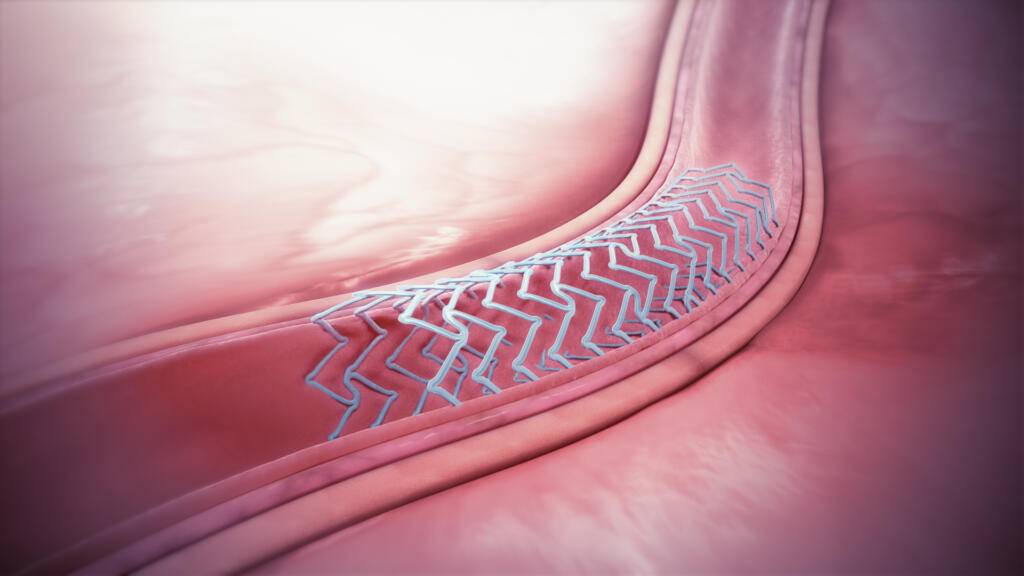Implanted stents have saved countless lives. A tiny metal mesh coil, stents keep arteries open for blood to flow that’s crucial to the body to function after a traumatic angioplasty or cardiac event.
That doesn’t mean they’re a perfected technology.
Stents themselves can also develop plaque due to the systemic nature of the same cardiovascular disease they were implanted to counteract. With cardiovascular disease the leading cause of death globally, according to the World Health Organization, the need for more effective stents has never been greater.
Guillermo Ameer, Cheng Sun
Recent work from Northwestern Engineering’s Guillermo Ameer could allow the re-stenting of an artery to restore blood flow with a dissolvable product, a process that currently is not possible.
Using a 3D printing technology called microCLIP developed at Northwestern by Professor Cheng Sun, Ameer produced citrate-based bioresorbable vascular scaffolds (BVSs) with a strut thickness of 62 micrometers, which is thinner than a human hair. Struts of biodegradable coronary stents that were previously available on the market were too thick, and the biodegradable material used to produce them can cause clots and pro-inflammatory tissue responses.
Ameer’s stent can also slowly release the drug Everolimus, which is used to prevent vessels from re-occluding due to scar-like tissue after angioplasty, by depositing a drug- citrate-based polymer coating onto the 3D-printed BVS. This drug is currently used in commercially available metal stents. The BVSs were successfully deployed into an animal’s coronary arteries using a custom-built delivery system and showed similar safety and efficacy to the commercial metal drug-eluting stent Xience in maintaining vessel patency for 28 days.
“Blood vessels treated with our bioresorbable vascular scaffolds were able to regenerate their endothelium, the inner cell layer in contact with blood that when healthy prevents clots.” Ameer said. “The biomaterial and 3D-printing technology we used is scalable and can be mass produced, opening the door to wider use of biodegradable stents that match the dimensions and performance of metal stents. It may also enable patient-specific medical device implants.”
The biomaterial and 3D-printing technology we used is scalable and can be mass produced, opening the door to wider use of biodegradable stents that match the dimensions and performance of metal stents. It may also enable patient-specific medical device implants.
Guillermo AmeerDaniel Hale Williams Professor of Biomedical Engineering at the McCormick School of Engineering and Professor of Surgery at the Feinberg School of Medicine
Ameer is the Daniel Hale Williams Professor of Biomedical Engineering at the McCormick School of Engineering and professor of surgery at the Feinberg School of Medicine. He detailed this work in the paper “3D-Printed, Citrate-Based Bioresorbable Vascular Scaffolds for Coronary Artery Angioplasty,” published online last month in the peer-reviewed academic journal Bioactive Materials.
The director of Northwestern’s Center for Advanced Regenerative Engineering (CARE), Ameer previously pioneered the development and tissue regeneration applications of citrate-based biomaterials, which are the core technology behind the innovative bioresorbable orthopedic tissue fixation devices CITRELOCK, CITREFIX, CITRESPLINE, CITRELOCK ACL, and CITRELOCK DUO. All of these devices have been cleared by the FDA for clinical use in musculoskeletal surgeries.
Sun is a professor of mechanical engineering. His research group is engaged in developing novel nanoscale fabrication techniques and integrated nanosystems for bio-sensing and high-efficiency energy conversion.
Collaboration from a chance encounter
Sun’s research dovetails with Ameer’s work. Around a decade ago, Ameer and Sun began collaborating after meeting in a hallway. Ameer had developed a new type of biodegradable material made from citric acid and was looking into using it for blood vessel support structures. At that time, Sun was working on creating a high-resolution 3D printer designed for tiny, detailed projects.
Over time, we have continuously enhanced our 3D printing technology, improving both its speed and the detail it can achieve.Cheng Sun
The two combined their expertise and technologies. After it took nine hours to print one blood-vessel support system, Sun developed microCLIP, an advanced version of technology created at the University of North Carolina. microCLIP significantly enhances resolution and surpassed existing commercial systems.
Now, Ameer and Sun can produce seven BVSs in seven minutes, and 3D print features as small as 2 micrometers. That high resolution allows them to consistently produce BVS with a strut thickness as small as 62 micrometers.
“By 3D printing via a continuous stage motion, microCLIP effectively handles viscous ink for high-speed printing while also enhancing mechanical integrity, both of which are essential for the success of this project,” Sun said. “Over time, we have continuously enhanced our 3D printing technology, improving both its speed and the detail it can achieve.”


